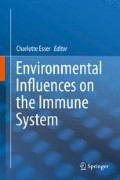Abstract
All living organisms are in constant exchange with the environment: its climate and physical conditions, chemicals, radiation, and last but not least other organisms. Among these, pathogenic microbes are a constant threat to health. Consequently, all organisms have developed strategies to prevent damage by bacterial, viral, and fungal pathogens. In vertebrates a highly complex defense mechanism has evolved, which goes far beyond “eat-and-destroy-the-bugs” strategies of evolutionary older organisms like prokaryotes or invertebrates. This mechanism is called the immune system. The immune system is different from other organs. It is distributed across the entire body and comprises organ structures, cells, and molecules such as antibodies and cytokines. It has a vast array of functionally different cells (T and B lymphocytes, macrophages, neutrophils, mast cells, to name just a few). While some cells remain tissue bound, others can move around the body and shuttle between the blood and lymph vessels and tissues. The immune system comprises lymphoid organs such as bone marrow, thymus, lymph nodes, or the spleen, which all form developmental niches for immune and blood cell development (hematopoiesis) and act as contact centers for interaction of immune cells. Indeed, the immune system is constantly renewing itself from hematopoietic stem cells, and the highly organized differentiation of cells is an important functional feature of immune responses. The immune system is unique in its memory: it will fight pathogens better, faster, and more vigorous on a second encounter. Finally, the immune system is a paradigm of checks and balances. In order to prevent attacking and damaging its own body or overreacting to harmless environmental cues, immune responses not only entail immune activation but also spend much effort on immunosuppression. Adverse immune reactions occur when either the discernment of antigens as harmless or harmful fails or when the immune system attacks proteins of its own body as antigens. Finally, chemicals, drugs, stress, or certain environmental conditions can suppress the immune system with severe health consequences. Immunotoxicology is the discipline which deals with unwanted, adverse immune responses caused by the (chemical and physical) environment. In this chapter, I want to introduce major players of the immune system and major current concepts of its operation strategies, with a special emphasis on interactions with the environment. This shall give a framework for a better understanding of the chapters which deal with particular situations of the environment–immune system interaction.
Access this chapter
Tax calculation will be finalised at checkout
Purchases are for personal use only
Notes
- 1.
Cell surface proteins are often used to name or characterize immune cells. Cell surface proteins were first distinguished serologically in various laboratories by raising antibodies against immune cells, and if the same molecule was discovered in parallel, several names existed. Eventually, to bring order into chaos, the highly useful nomenclature of “clusters of differentiation,” or CD molecules, was developed. CD molecules are assigned a number in chronological order (Zola et al. 2007). Currently, there are more than 350 CD known. For many CD molecules, the underlying proteins and their function(s) have been characterized by now.
References
Abbas A, Lichtmann AHH, Pillai S (2015) Cellular and molecular immunology. Elsevier, Philadelphia
Descotes J (2005) Immunotoxicology: role in the safety assessment of drugs. Drug Saf 28:127–136
Griem P, Panthel K, Kalbacher H, Gleichmann E (1996) Alteration of a model antigen by Au(III) leads to T cell sensitization to cryptic peptides. Eur J Immunol 26:279–287
Hibi T, Dosch HM (1986) Limiting dilution analysis of the B cell compartment in human bone marrow. Eur J Immunol 16:139–145
Hirano M, Das S, Guo P, Cooper MD (2011) The evolution of adaptive immunity in vertebrates. Adv Immunol 109:125–157
Janeway CA, Medzhitov R (2002) Innate immune recognition. Annu Rev Immunol 20:197–216
Kerkvliet NI (2012) TCDD: an environmental immunotoxicant reveals a novel pathway of immunoregulation – a 30-year odyssey. Toxicol Pathol 40:138–142
Luster MI, Munson AE, Thomas PT, Holsapple MP, Fenters JD, White KL Jr, Lauer LD, Germolec DR, Rosenthal GJ, Dean JH (1988) Development of a testing battery to assess chemical-induced immunotoxicity: national toxicology program’s guidelines for immunotoxicity evaluation in mice. Fundam Appl Toxicol 10:2–19
Luster MI, Portier C, Pait DG, Rosenthal GJ, Germolec DR, Corsini E, Blaylock BL, Pollock P, Kouchi Y, Craig W (1993) Risk assessment in immunotoxicology. II. Relationships between immune and host resistance tests. Fundam Appl Toxicol 21:71–82
Navid F, Bruhs A, Schuller W, Fritsche E, Krutmann J, Schwarz T, Schwarz A (2013) The aryl hydrocarbon receptor is involved in UVR-induced immunosuppression. J Invest Dermatol 133:2763–2770
Paul W (2013) Fundamental immunology, 7th edn. Lippincott, Williams & Wilkins, Philadelphia
Putman E, van der Laan JW, van Loveren H (2003) Assessing immunotoxicity: guidelines. Fundam Clin Pharmacol 17:615–626
Spits H, Artis D, Colonna M, Diefenbach A, Di Santo JP, Eberl G, Koyasu S, Locksley RM, McKenzie AN, Mebius RE, Powrie F, Vivier E (2013) Innate lymphoid cells – a proposal for uniform nomenclature. Nat Rev Immunol 13:145–149
Zola H, Swart B, Banham A, Barry S, Beare A, Bensussan A, Boumsell L, Buckley D, Buhring HJ, Clark G, Engel P, Fox D, Jin BQ, Macardle PJ, Malavasi F, Mason D, Stockinger H, Yang X (2007) CD molecules 2006 – human cell differentiation molecules. J Immunol Methods 319:1–5
Author information
Authors and Affiliations
Corresponding author
Editor information
Editors and Affiliations
Rights and permissions
Copyright information
© 2016 Springer-Verlag Wien
About this chapter
Cite this chapter
Esser, C. (2016). Principles of the Immune System: Players and Organization. In: Esser, C. (eds) Environmental Influences on the Immune System. Springer, Vienna. https://doi.org/10.1007/978-3-7091-1890-0_1
Download citation
DOI: https://doi.org/10.1007/978-3-7091-1890-0_1
Published:
Publisher Name: Springer, Vienna
Print ISBN: 978-3-7091-1888-7
Online ISBN: 978-3-7091-1890-0
eBook Packages: Biomedical and Life SciencesBiomedical and Life Sciences (R0)

